Plan checklist
Karen cannon
, Backyard Pond - Shoreline Kit
Planting plan created by Quinte Conservation
Funded by •
Schedule A:
Plants & Property
Land Characteristics
This planting plan is designed based on the land characteristics identified during the day of the site visit. Plants are chosen according to the soil and light conditions on your property. The number of plants chosen for each planting compartment takes into account the square metre area of the space, as well as the amount of current vegetation cover. Your property is part of ecoZone: 5b
Land Characteristics by Compartment
| Length | Width | Area | pH | Soil | Moisture | Light | Height | |
|---|---|---|---|---|---|---|---|---|
| A | 5m | 2m | 10m2 | normal | loamy | dry, normal | full sun, partial sun | |
| B | 10m | 8m | 80m2 | basic | loamy, clay | normal, moist | full sun, partial sun, shade | |
| C | 10m | 2m | 20m2 | normal | loamy, clay, humus | moist | partial sun | |
| D | 5m | 5m | 25m2 | normal | loamy, clay | normal, moist | full sun, partial sun | |
| 30m | 4.25m | 135m2 |
Plant Selection Summary
The following shrubs and trees are chosen for their suitability and survivability given the current soil and light conditions in each compartment on your property, as well as preferable features.
| Plant Species | A | B | C | D | Potted | Bareroot | Wildflower |
|---|---|---|---|---|---|---|---|
| Highbush Cranberry | 2 | 1 | 3 | ||||
| Black Elderberry | 1 | 1 | 1 | 3 | |||
| Black Chokeberry | 1 | 1 | 1 | 3 | |||
| Ninebark | 3 | 1 | 4 | ||||
| Allegheny Serviceberry | 4 | 1 | 5 | ||||
| Pasture Rose | 3 | 3 | |||||
| Narrow Leaved Meadowsweet | 2 | 2 | |||||
| Shrubby Cinquefoil | 3 | 3 | |||||
| Pussy Willow | 1 | 1 | |||||
| Blue Flag Iris | 2 | 2 | |||||
| Spotted Joe-Pye Weed | 2 | 2 | 4 | ||||
| Boneset | 1 | 1 | |||||
| Swamp Rose | 2 | 2 | |||||
| Pin Cherry | 1 | 1 | |||||
| Winterberry Holly | 1 | 1 | |||||
| Buttonbush | 2 | 2 | |||||
| Smooth Wild Rose | 4 | 4 | |||||
| Alternate-Leaved Dogwood | 1 | 1 | |||||
| Purple Coneflower | 3 | 3 | |||||
| Sweet Oxeye | 2 | 2 | |||||
| Subtotal | 11 | 16 | 5 | 18 | 23 | 15 | 12 |
| Totals | 50 | ||||||
Plant Information
The following table summarizes key information about each plant selected for your property.
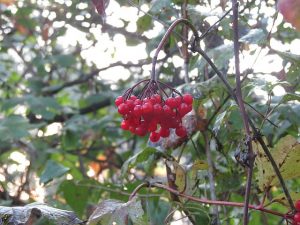
|
Highbush CranberryHeight: 3 m
Highbush Cranberry is a large deciduous shrub species that typically grows about 3 m in height. The branches on this shrub are dense with arching stems, creating a full form. The leaves are oppositely arranged, Maple leaf shaped, have 3 lobes, and have entire or toothed margins. The flowers are showy, creamy white coloured, appear in flat clusters with larger florets surrounding smaller ones, and bloom between May and June. These flowers change into drooping, bright red berry clusters that persist throughout the winter. While the berries are edible to humans, they are very tart when consumed raw so are typically cooked first. This shrub has very attractive fall foliage, changing a reddish purple colour. The flowers are beneficial to pollinator species, like bees and butterflies. The fruit is beneficial to wildlife species, including birds and small mammals. The root system is extensive, making this shrub valuable for controlling erosion and stabilizing loose soil. This species can be found across Canada from Newfoundland to British Columbia, but is most commonly found in Ontario and Quebec.
|
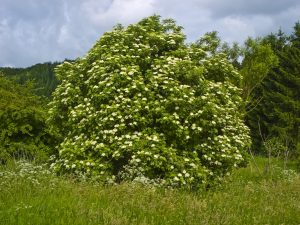
|
Black ElderberryHeight: 4 m
The Black Elderberry is a large, fast-growing, deciduous shrub or small tree, which typically grows to 4m. This species tolerates a variety of conditions and is commonly found in sunny locations with well-drained soils. Black Elderberry can be single or multi-stalked with numerous branches creating a full, round body. Leaves are compound, with 5-7 leaflets that grow opposite each other along the branch. During the fall, leaves tend to turn a pale yellow. During late May to early June, this species produces flowers that are ivory white and grow in flat topped clusters. By late August, flowers turn to glossy, deep purple fruit, which attract a variety of wildlife like songbirds and small mammals. Ripe fruit is edible for humans and is commonly made into jams and jellies. The root system of this species is shallow, and can form colonies through suckering.
|
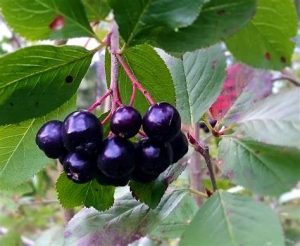
|
Black ChokeberryHeight: 1-3m
The Black Chokeberry is a medium sized deciduous shrub that typically grows between 1-3m with edible fruit. This species requires full sun to partial shade and can tolerate soil conditions from loamy and moist to rocky and dry. Naturally, Black Chokeberry is found in wet wooded areas such as; swamps, along shorelines, and within forest understory. This species is multi-stemmed, and forms thickets from stems which arise from the roots. Leaves are simple, growing alternately along the branch turning a bold red to orange during the fall. During spring, clusters of showy, white flowers appear turning into dark purple berries by fall. This species is resistant to drought, insects, pollution, and disease. The Black Chokeberry is often cultivated as an ornamental plant and food product. Additionally, this species is useful for bank stabilization and erosion control applications.
|
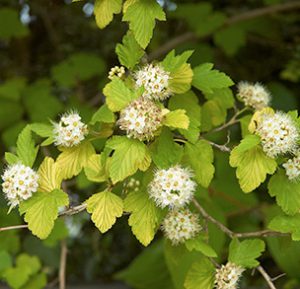
|
NinebarkHeight: 2-3m
The Common Ninebark is a very hardy, large (2-3m in height), deciduous shrub naturally occurring within riparian zones. This species is often planted as an ornamental shrub for its exfoliating bark which reveals reddish-light brown inner bark. This shrub is multi-stemmed with numerous horizontal and ascending branches creating a full, round shape. The Common Ninebark produces dull green, ovate to round shaped leaves with three to five lobes per leaf. During the fall the leaves turn brilliant yellow or dark purple. Between May and June, showy, bell-shaped flowers bloom in clusters on the terminal ends of the branches. During the summer, these flowers give way to small green or green-yellow berries which turn a bright red upon ripening.
|
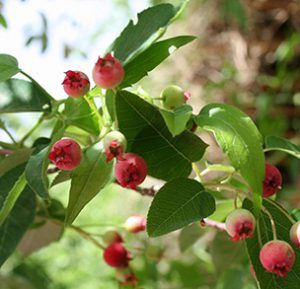
|
Allegheny ServiceberryHeight: 3-10 m
The Allegheny Serviceberry is an attractive deciduous shrub species that can reach about 3 m as a shrub or up to 10 m as a tree. This plant may also be known by the common name Smooth Serviceberry. It can be grown either in the form of a single stem tree or multi-stemmed shrub comprised of two or three smaller trunks. The leaves are dark green, alternately arranged, oval shaped, and have finely toothed margins. The flowers are showy, fragrant, have 5 petals, appear in drooping clusters, and bloom in April before the leaves emerge. The flowers produce small reddish purple to black berries, which are edible and flavorful to humans. The fruit is beneficial to wildlife species, including birds and small mammals. The root system is valuable for controlling erosion and stabilizing loose soil. This plant is often used for ornamental purposes as a small tree in urban areas.
|
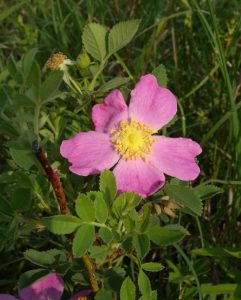
|
Pasture RoseHeight: 1.5 m
The Pasture Rose is a small (1.5m), deciduous shrub which often spreads through suckers to form colonies or thickets in the wild. This species grows erect from a central base with sprawling branches, creating a dense, irregular bush. This shrub produces compound leaves, consisting of 5 to 7 leaflets arranged alternately along the branches. The Pasture Rose yields beautiful 5 centimeter wide white to pink flowers, which bloom in the early summer lasting for approximately a month. The rose hip fruit develops after the flower has died and turns bright red as it ripens. During the fall, the olive green leaves turn yellow to deep red or purple.
|
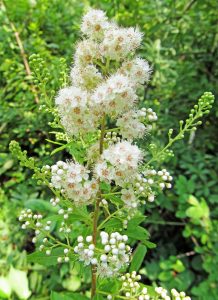
|
Narrow Leaved MeadowsweetHeight: 1-2m
The Narrow Leaved Meadowsweet is an erect, deciduous shrub, which grows in the shape of a mound to a height of 1-2m. This species develops numerous branches and branchlets, giving it a sparse appearance. Leaves produced are simple and narrow with sharply toothed borders growing alternately along the branches. These bright, light green leaves appear crowded, as they grow close together on the stocks and branches. During the fall, leaves turn a yellow-red or yellow-orange colour. Small white to light pink flower clusters appear in the spring growing in a dense, narrow pyramid at the terminal ends of the branches. During late summer to early fall, these flowers produce smooth, papery seed pods.
|
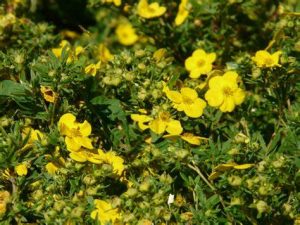
|
Shrubby CinquefoilHeight: 1 m
Shrubby Cinquefoil is a hardy, deciduous shrub species that grows about 1 m in height. The stems are reddish brown to gray and appear shredded with age. The leaves are green to blueish green, narrow and elliptic shaped, hairy, alternately arranged, compound with 5 leaflets, and have entire margins. The flowers are showy, yellow, saucer shaped, have five petals, appear in small clusters on terminal branches, and bloom between June and September. In the fall, the flowers give way to an oval-shaped, brown fruit covered in white hairs. The flowers are beneficial to pollinator species, like bees and butterflies. This is a popular shrub for ornamental use in gardens.
|
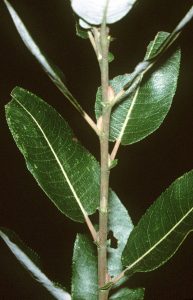
|
Pussy WillowHeight: 6m
The Pussy Willow is a fast growing, deciduous shrub or small tree found reaching heights of 6m, and is from British Columbia to Newfoundland. This species grows from shoots extending from the base of the trunk, creating a multi-stemmed, tall, round bush. The Pussy Willow is an ideal species for bank stabilization and erosion control due to its large, fibrous root system and love of water. This species branches extend from the main shoots and are usually hairy and reddish-brown in colour. The main shoots of Pussy Willow are smooth and greyish-brown, becoming scaly with age. It produces simple, narrow, lance-shaped leaves alternately arranged along the branch. The Pussy Willow yields purple-brown fuzzy catkins which will form long-beaked and finely haired capsules during May and June.
|
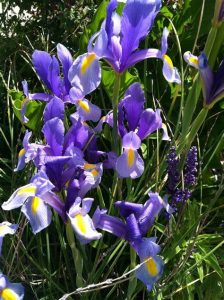
|
Blue Flag IrisHeight: 0.5 m
The Blue Flag Iris is a showy perennial wildflower that typically grows about 0.5 m in height. This plant may also be known by the common name Harlequin Blue Flag. The leaves are light green, sword-shaped, slightly arched or erect, and appear growing out as a cluster around the base of the plant. The attractive blue flowers start to bloom in the early spring, emerging from a tall flowering stalk that can reach up to 1 m. The flowers are beneficial to pollinator species, like bees and butterflies. The seeds are also beneficial to wildlife species, like birds and small mammals.
|
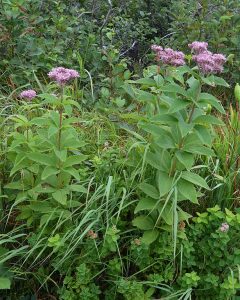
|
Spotted Joe-Pye WeedHeight: 1.5 m
Spotted Joe-Pye Weed is a colourful wildflower species that can grow up to 1.5 m tall and can spread about 1 m. It has a plain or spotted purple stem, which is sometimes covered in fine hairs. The leaves are large, lanceolate shaped, have serrated edges, and appear in whorls of 3-5. The flowers are showy, fragrant, bright pink/purple coloured, have 8-20 disk florets, appear in clusters at the top of a flowering stem, and bloom in mid to late summer. The flowers are beneficial to pollinator species, like bees and butterflies. This plant spreads well and can form small colonies. The roots can be useful for controlling erosion and stabilizing shorelines.
|
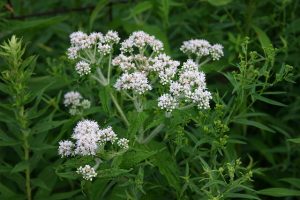
|
BonesetHeight: 1.5 m
Common Boneset is a wildflower species that can grow up to 1.5 m in height. This plant may also be known by the common name Thoroughwort. The leaves are oppositely arranged, dark green coloured, lanceolate shaped, wrinkly, have long narrow tips, serrated margins, and distinctively unite through the plant’s hairy stem. The flowers are tiny, white coloured, appear in flat-topped clusters, and bloom between July and September. The flowers are beneficial to pollinator species, like bees and butterflies. All parts of the plant are toxic. This wildflower spreads well and can be used to naturalize un-vegetated areas.
|
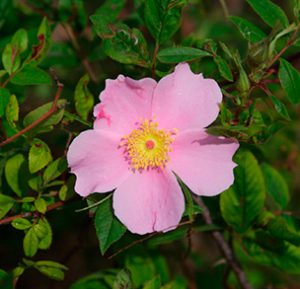
|
Swamp RoseHeight: 2m
The Swamp Rose is a beautiful perennial shrub species that typically grows 2m in height and spreads 2m. It is visually appealing with large pink flowers that last about 6-8 weeks. These flowers have five pink petals, a yellow center, and a pleasant fragrance. This species produces oblong shaped, compound leaves comprised of seven leaflets with serrated edges. The Swamp Rose produces red, round, fleshy fruit called rose hips, which remain on the bush throughout winter. These fruiting bodies provide a winter food source for wildlife, such as Grouse, Black Bears, Deer, and Rabbits. Swamp Rose may be confused with Prickly Wild Rose, which has a similar appearance. However, Swamp Rose can easily be distinguished by the presence of curved thorns, which appear at the nodes of the twigs without any occurring between the nodes. Swamp Rose grows best in moist, rich soils such as swamps and marshy shorelines. However, this species can also tolerate drier, loamy soils.
|
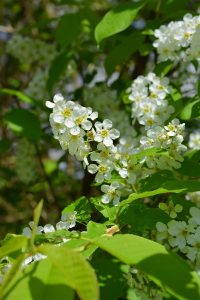
|
Pin CherryHeight: 12m
The Pin Cherry is a large, deciduous shrub or small tree which is widespread across Canada which typically grows 12m. This species may also be referred to as Fire Cherry as this shrub can rapidly establish within an area following a fire. The Pin Cherry grows from a single, straight trunk with numerous branches creating a narrow, rounded crown. The bark is shiny, dark reddish-brown with large horizontal lenticels. Leaves are simple, 6 to 12 cm long and lance-shaped with finely serrated margins arranged alternately along the branches. During the fall, the leaves turn a bright red to deep purple colour. During the early spring, the Pin Cherry produces showy, small white flower clusters which give rise to numerous edible red berries resembling pin heads. These berries provide a food source to numerous song and game bird species, as well as small mammals. The root system of the Pin Cherry is shallow, with the roots growing laterally, making it an ideal species to address erosion and bank stability issues.
|
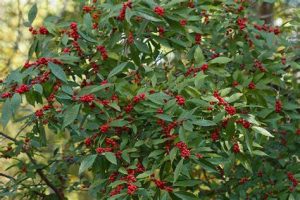
|
Winterberry HollyHeight: 3 m
Winterberry is a deciduous shrub species that typically grows about 3 m in height. The leaves are dark green coloured, alternately arranged, and have toothed margins. The flowers are small, greenish white coloured, not showy, and bloom between June and July. The fruits are attractive, bright red berries, which are not edible, only grow on female plants nearby male plants, and persist throughout the winter, hence the name. This plant spreads well and can form small colonies. The roots can useful for controlling erosion and stabilizing shorelines. The berries are highly beneficial to wildlife species, like birds and small mammals, throughout the winter.
|
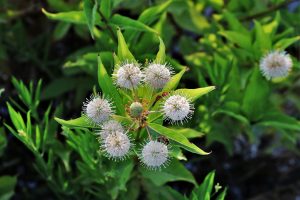
|
ButtonbushHeight: 2 m
Buttonbush is a small to medium-sized deciduous shrub species which typically grows about 2 m in height. This plant may also be known by the common name Button Willow. Twigs are slender to stout and dark red-brown in colour with white speckling. The leaves are bright green coloured, shiny, ovate shaped, oppositely arranged, and have entire margins. The flowers are tiny, tubular, white, fragrant, and appear densely on distinctive, spherical clusters in June. These flowers turn into a dense cluster of seeds, which remain on the plant throughout the winter. The flowers are beneficial for pollinator species, including hummingbirds and butterflies. This is a hardy, adaptable species and an excellent choice for planting on wet shoreline sites.
|
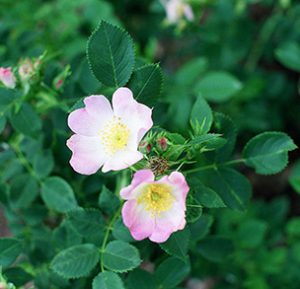
|
Smooth Wild RoseHeight: 1.5m
The Smooth Wild Rose is a shrub species that grows about 1.5 m tall. The name is derived from the fact that it is almost thornless with only a few sharp thorns present near its base. This native shrub is best known for producing beautiful pale pink flowers with five saucer-like petals surrounding a yellow center. The Smooth Wild Rose produces bright red rose hip fruiting bodies which develop during the summer and persist throughout the winter. Leaves produced are alternate and compound, consisting of 5-7 serrated, egg-shaped leaflets.
|
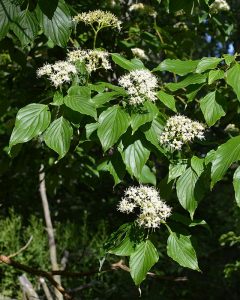
|
Alternate-Leaved DogwoodHeight: 5-10 m
The Alternate-Leaved Dogwood is a tall, deciduous shrub or small tree species that can grow 5-10 m in height. This plant may also be known by the common name Pagoda Dogwood. It can be grown either in the form of a single stem tree or multi-stemmed shrub comprised of two or three smaller trunks. The leaves are ovate shaped, alternately arranged, have prominent veins, have a pointed tip, and have entire margins. The flowers are showy, fragrant, whitish yellow, appear in flat clusters, and bloom between May and June. These flowers produce clusters of dark blue berries. The flowers are beneficial for pollinator species while the berries are beneficial for wildlife species. The root system is valuable for controlling erosion and stabilizing loose soil. This plant is often used as a small ornamental tree in landscaping. The common name comes from the fact that all other Dogwood species have oppositely arranged leaves.
|
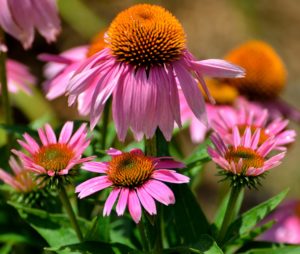
|
Purple ConeflowerHeight: 1m
Purple Coneflower is a perennial wildflower that typically grows about 1 m tall. This plant may also be known by the common name Echinacea. The leaves are dark green coloured, alternately arranged, lance shaped with pointed tips, and have serrated margins. The flowers are showy, pale purple to pink, have 15-20 toothed petals, appear atop erect stems, and bloom between June and August. This wildflower spreads well and can be used to naturalize un-vegetated areas. The roots can be useful for controlling erosion and stabilizing shorelines. This flower blooms for long periods. The flowers are beneficial to pollinator species, like bees and butterflies. The seeds are also beneficial to wildlife species, like birds and small mammals.
|
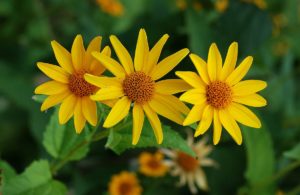
|
Sweet OxeyeHeight: 2m
Sweet Oxeye, also known as False Sunflower, is an attractive, herbaceous, perennial wildflower, which can grow to almost 2 m tall. The flowers are perched atop a stiff stem, with a brownish-yellow center cone surrounded by bright yellow to orange rays. Leaves are 5-12 cm long and 2-8 cm wide, oppositely arranged along the stem, ovate to lanceolate in shape, and have a toothed margin. This wildflower grows best in moist, well-drained soils, preferring full sun, but will tolerate partial shade. Some common natural habitats for the Sweet Oxeye are prairies, meadows, forest edges, and stream banks. Sweet Oxeye is drought tolerant so could be planted in difficult dry sites, but will grow best with regular watering. A large variety of insect species are attracted to the Sweet Oxeye, making it a great addition to a habitat garden.
|
Compartment A
Naturalization Area
 pH: normal
pH: normal Depth: bareroot
Depth: bareroot-
 Moisture: dry, normal
Moisture: dry, normal -
 Soil Type: loamy
Soil Type: loamy -
 Light conditions: full sun, partial sun
Light conditions: full sun, partial sun
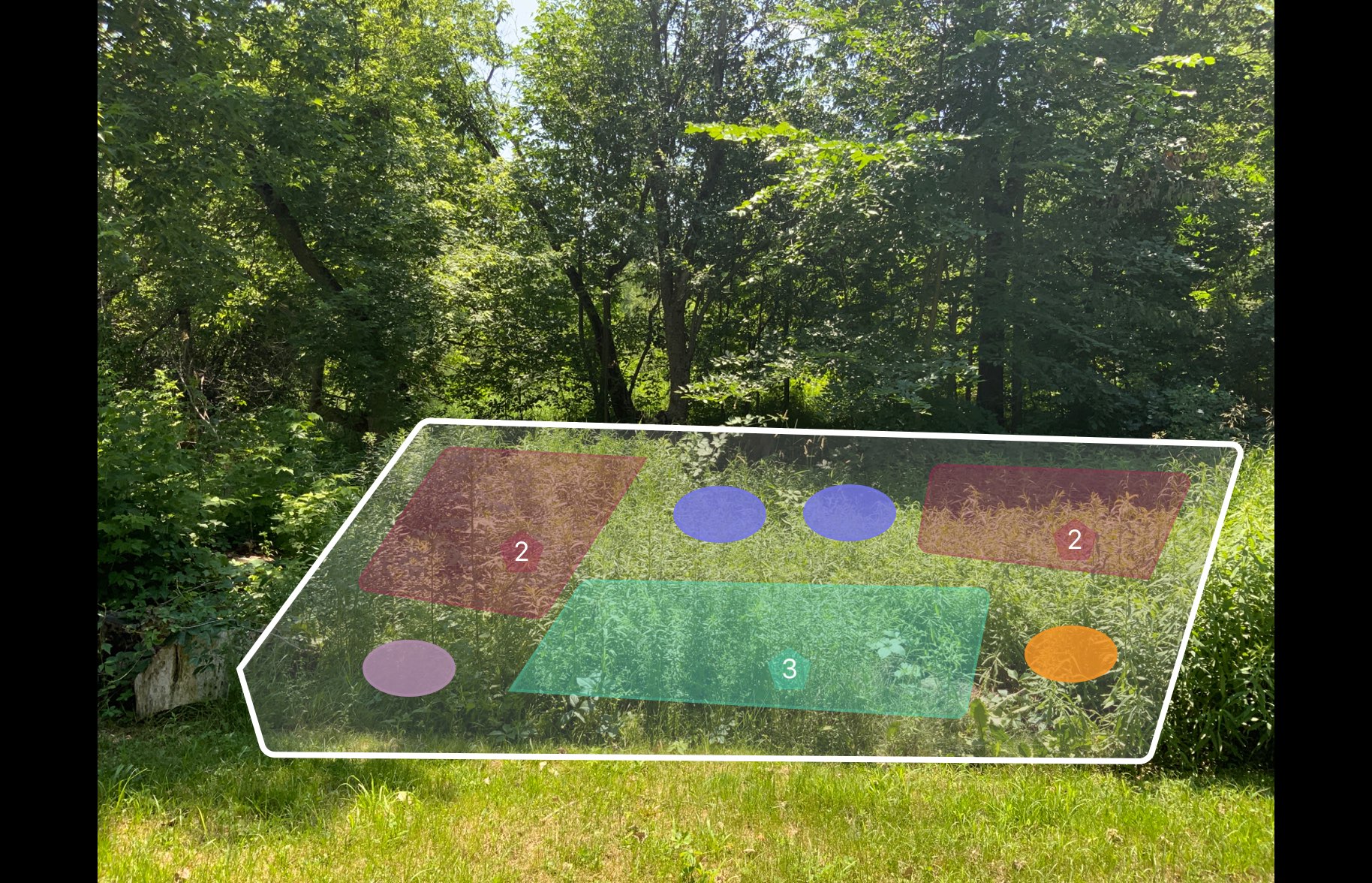
Compartment B
Naturalization Area
 pH: basic
pH: basic Depth: potted, bareroot, wildflowers
Depth: potted, bareroot, wildflowers-
 Moisture: normal, moist
Moisture: normal, moist -
 Soil Type: loamy, clay
Soil Type: loamy, clay -
 Light conditions: full sun, partial sun, shade
Light conditions: full sun, partial sun, shade
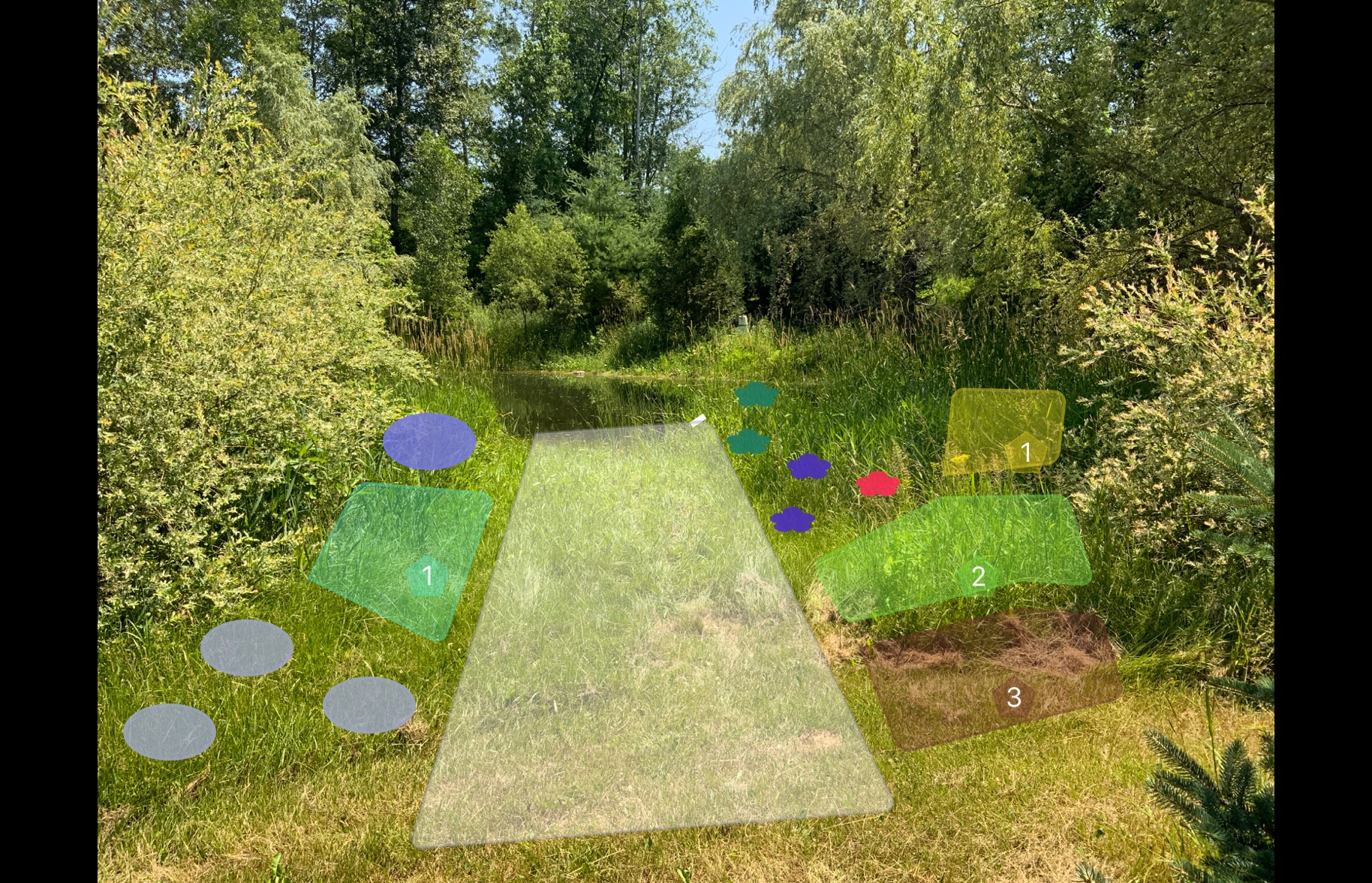
Compartment C
Naturalization Area
 pH: normal
pH: normal Depth: bareroot
Depth: bareroot-
 Moisture: moist
Moisture: moist -
 Soil Type: loamy, clay, humus
Soil Type: loamy, clay, humus -
 Light conditions: partial sun
Light conditions: partial sun
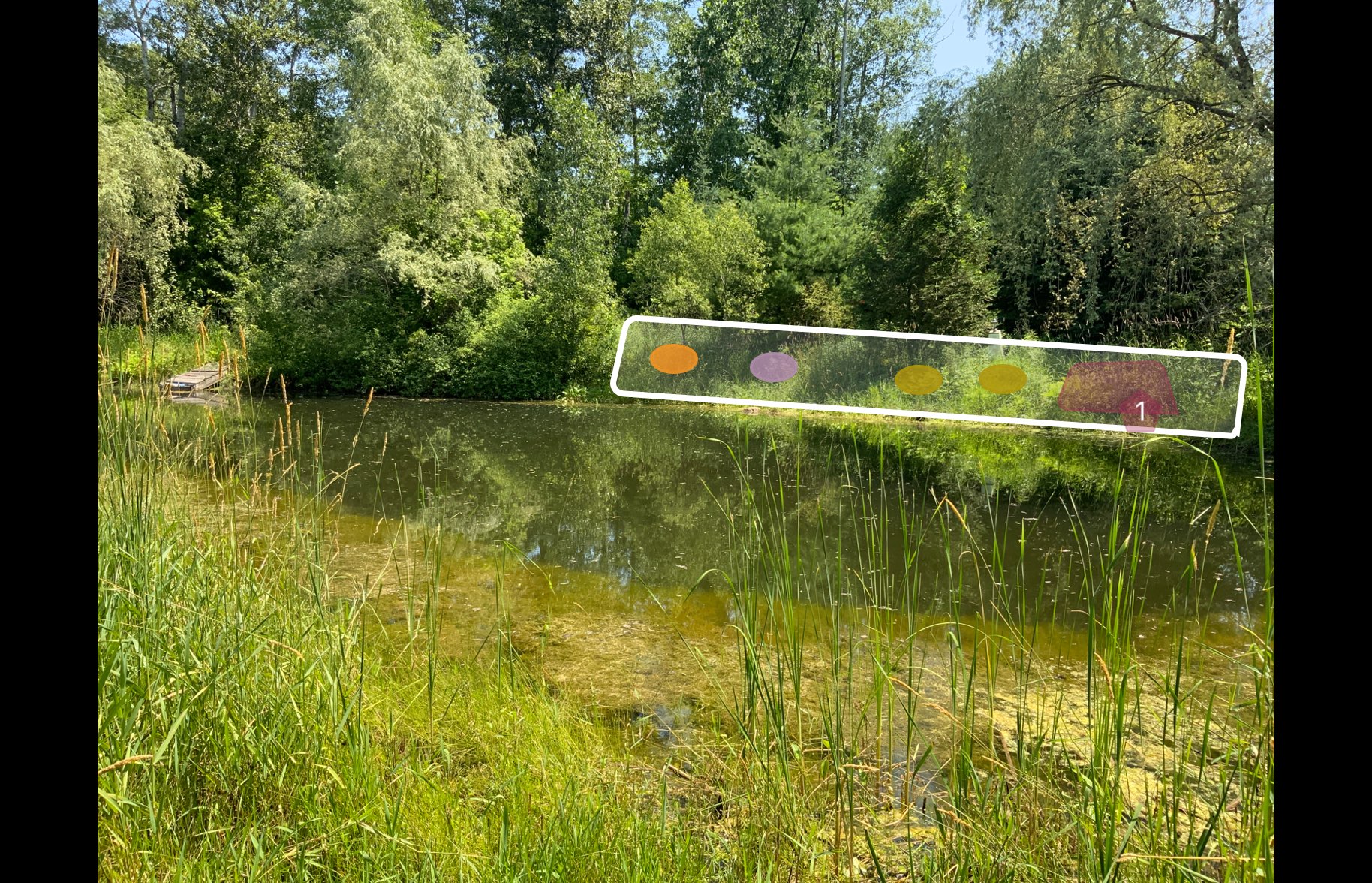
Compartment D
Naturalization Area
 pH: normal
pH: normal Depth: potted, bareroot, wildflowers
Depth: potted, bareroot, wildflowers-
 Moisture: normal, moist
Moisture: normal, moist -
 Soil Type: loamy, clay
Soil Type: loamy, clay -
 Light conditions: full sun, partial sun
Light conditions: full sun, partial sun
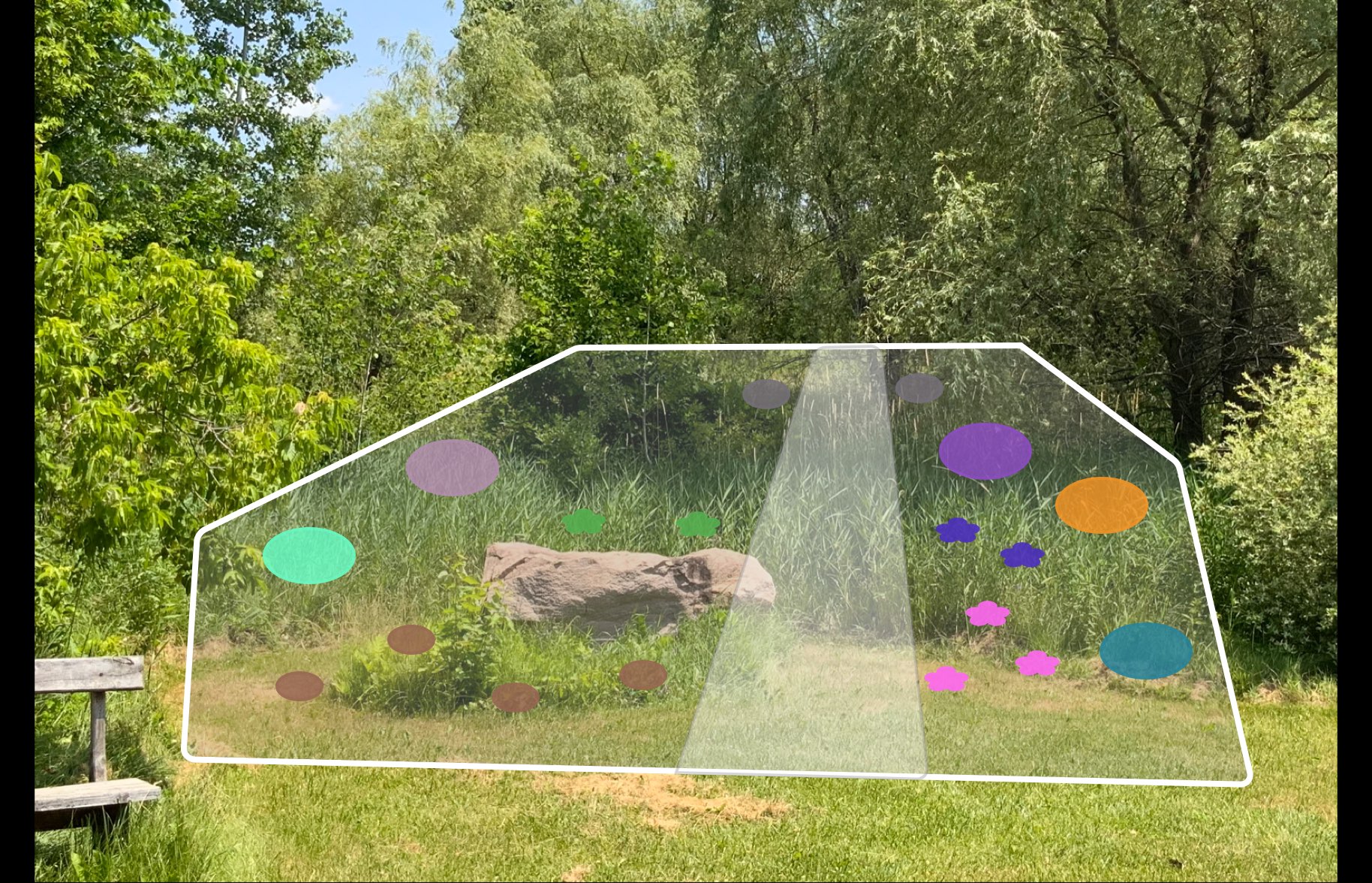
Schedule B
Financial Summary
Project by: Quinte Conservation
Shoreline Re-Naturalization Starter Kit includes: free site visit, customized re-naturalization planting plan for your shoreline property, native plants including free bare root (small) and potted (large) plants and wildflowers, coconut fibre pads to deter grass from growing around new plantings, tree guards for all deciduous trees, mulch for your wildflowers, Plant Care Guide with instructions on how to take care of your new plants, Habitat Creation Guide and a Wildflower Garden Guide.
Our planting plans are created onsite with you and provide detailed information and plans to re-naturalize your shoreline property. We take photos of areas for planting and overlay native plants that are well suited to your property based on site conditions such as soil type and sunlight availability.
We will work with you to create a plan that works for you including options for low growing plants in areas where views are important.
| Item | Quantity | Cost/Item | Subtotal |
|---|---|---|---|
| Starter Kit fee | $451 | ||
| Free potted plants | 23 | $0 | $0 |
| Free bareroot plants | 0 | $0 | $0 |
| Paid bareroot plants | 15 | 2.58 | 38.70 |
| Free wildflowers | 12 | $0 | $0 |
| Total costs | 489.70 |
Schedule C
Project Agreement
Stewardship Agreement
Please indicate your agreement to this proposed plan by signing the following Stewardship Agreement and submitting it, along with your financial contribution, to:
Quinte Conservation
2061 Old Highway #2
RR#2, Belleville, Ontario
K8N4Z2
Plant Availability
Please note that plant species may need to be changed based on plant stock availability at the time of ordering.
Project Completion
Upon receiving your signed stewardship agreement and financial contribution, a date will be booked for you to pick up your Natural Edge Kit. Quinte Conservation will supply all plants and materials. If you are paying for the planting to be completed for you, a date will be arranged for Quinte Conservation to plant your shoreline, bringing the plants and materials with them. If there are particular dates that you would prefer, we will do our best to accommodate your requests.
The Natural Edge Stewardship Agreement with Quinte Conservation
Agreement made this 17th Day of the Month of July in the Year 2020.
BETWEEN K. Cannon Ontario K0K3HO (Hereinafter called the OWNERS)
AND Quinte Conservation 2061 Old Highway #2 RR#2, Belleville, Ontario K8N4Z2 (Hereinafter called QC)
WHEREAS the Owners and QC have met and discussed plans for shoreline naturalization on the specified area(s) in Schedule A existing on the Owners’ land;
WHEREAS the Owners indicate approval of the project as proposed; and
WHEREAS the project is, or will be for the benefit of the Owners and others;
NOW THEREFORE THE PARTIES AGREE AS FOLLOWS:
1. This Agreement shall be in effect for a period of 5 years, commencing with the date of this Agreement.
2. The Owners and QC agree that the areas where the work is to be performed is as described in Schedule A.
3. The Owners agree to pick up their Natural Edge Starter Kit from QC’s office and plant their shoreline within two days of receipt. The Owners will provide “after” photos of the work completed to be used for reporting purposes. If the Owners wish to have the planting completed for them, then QC or it’s contractors, employees and agents will complete the planting at cost, as indicated in Schedule B.
4. If the planting is to be completed by QC, then the Owners grant QC, its contractors, employees and agents, the right to enter the property to perform the work agreed upon as outlined in Schedule A. In addition, QC, its contractors, employees and agents may inspect the work performed for the purposes of monitoring the project and survival assessment, with prior agreement with Owners for date and time of inspection.
5. The Owners agree to contribute the “Landowner contribution” and pay the costs indicated in Schedule B.
6. In instances where the Owners are to pay QC for work to be performed (outlined in Schedule A), the Owners agree to provide payments to QC prior to the commencement of that operation. Failure of payment shall constitute a breach of this Agreement and the Owners agree that this Agreement will be terminated and thereupon the Owners agree to pay QC the estimated costs of the operations of the project completed to date, if any.
7. The Owners agree, if necessary, to perform a reasonable amount of maintenance, which is described in the Native Plant Care Guide, available at naturaledge.watersheds.ca.
8. If a contractor is required to perform the work outlined in Schedule A, then the contractor carrying out the work on the land described will be required to take out and furnish evidence of a comprehensive policy of public liability and property damage coverage. The contractor and their workers will be required to be in good standing with the Workplace Safety and Insurance Board (WSIB) prior to performing the work.
9. The Owners agree not to remove, destroy or alter the project without prior consultation and approval of QC. Pruning and trimming planted nursery stock, or adding replacement native nursery stock is exempt.
10. The Owners agree not to mow the planted area.
11. The Owners do acknowledge that QC, its contractors, employees and agents, having performed said works, are not under further obligation with respect to survival of nursery stock, inspection, or maintenance.
12. The Owners, in the absence of negligence, hereby remise, release and forever discharge QC, its contractors, employees and agents from all claims and demands for injuries, including death, loss, damages and costs in any way related to or connected with installation and maintenance of the work described or resulting from any deleterious effects of the work to the land or to the lands and buildings thereon retained by the Owners.
IN WITNESS WHEREOF the parties have agreed to the contents of this plan; SIGNED:
About this program
About Quinte Conservation
Quinte Conservation is a community based environmental protection agency that serves 18 municipalities in the watersheds of the Moira, Napanee and Salmon Rivers and Prince Edward County. Our programs, services and working alongside residents create a sustainable ecosystem where people and nature live in harmony.
This program was created by Watersheds Canada
We believe that every person has the right to access clean and healthy lakes and rivers in Canada. At Watersheds Canada, we work to keep these precious places naturally clean and healthy for people and wildlife to continue using for years to come. We love working with others to meet the needs of local communities, whether you’re a concerned citizen, a landowner, a lake association looking for help, or a coalition of groups interested in activating your local community.

